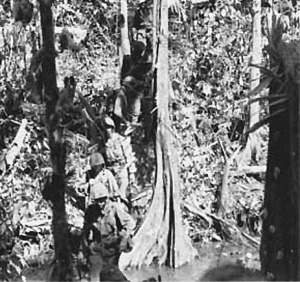![]() The Pacific War Online Encyclopedia
The Pacific War Online Encyclopedia
|
| Previous: SV Air Search Radar | Table of Contents | Next: Swatow |

U.S. Marine Corps
#72833. Via ibiblio.org
If there was any worse place to fight than a jungle, it would be a swamp. The men who fought in the South Pacific often did both at the same time, since many of the coastal areas where combat took place were swamp grading into jungle.
A swamp is an area of stagnant standing water,
shallow enough to permit aquatic vegetation to flourish but deep and
permanent enough to greatly hinder movement. Ecologists distinguish
bogs, which are choked with organic matter such as peat; marshes, which
lack organic matter and woody vegetation; and true swamps, which lack
organic matter but have woody vegetation. These distinctions meant
little to fighting infantry.
Swamps are found wherever there is flat,
inadequately drained terrain with
heavy rainfall, which describes much of the coast of New Guinea and Sumatra as well as portions of Malaya. Arctic bog was common in the Aleutians, where low
evaporation rates allowed water to accumulate. Arctic bog consisted of
organic muck covered with a thin layer of vegetation. Many of the
coastal areas of the south Pacific were mangrove swamps, where
saltwater-tolerant mangrove trees grew into a mass of interlocking
roots that trapped silt and debris. However, the rugged terrain of the Solomons meant that swamps were
uncommon there, and they were also uncommon in the atolls of the central Pacific, except
for isolated mangrove swamps.
Swamps often had patches of higher ground that
could support light traffic or fortifications.
During the Buna campaign, the Japanese carefully arranged their field
works to cover the few passable trails through the swamps south of Buna
village, forcing Allied
troops to fight under some of the worst conditions of the war. The
misery of attempting to move through these swamps was exceeded only by
the misery of trying to find cover in these swamps when one came under
fire. High ground in swamps could sometimes be identified by the presence of kunai grass or breadfruit trees, which grew only on more stable ground.
Swamps were ideal breeding ground for the mosquitoes
that transmitted malaria and other
tropical diseases. They were also infested with leeches, relatives of
earthworms that attach to vertebrates (including humans) to take a
blood meal. The wound caused by a leech could quickly become infected
in tropical climates. More frightening were the saltwater crocodiles
that inhabited coastal swamps throughout southeast Asia and were easily
capable of killing a man. Though there were relatively few confirmed
reports of Allied soldiers being attacked by crocodiles, it did happen. One victim was an Army captain at Cape Gloucester who lost an arm to crocodile attack while getting a drink from a river.
It has been claimed, but is disputed, that as many as several hundred
Japanese soldiers were killed by crocodiles while retreating from
Ramree Island off the Burma coast.
Engineers
could sometimes construct corduroy roads, made of logs laid
parallel, through swamps. These could take light foot traffic but were
unpleasant for vehicular traffic. A proper road required either
draining the swamp or building up a sufficient gravel base to raise the
road above the water level. Both could be arduous tasks and engineers
generally tried to find a way around the swamp instead.
References
burmastar.org.uk (accessed 2011-5-23)
The Pacific War Online Encyclopedia © 2008, 2010-2011 by Kent G. Budge. Index